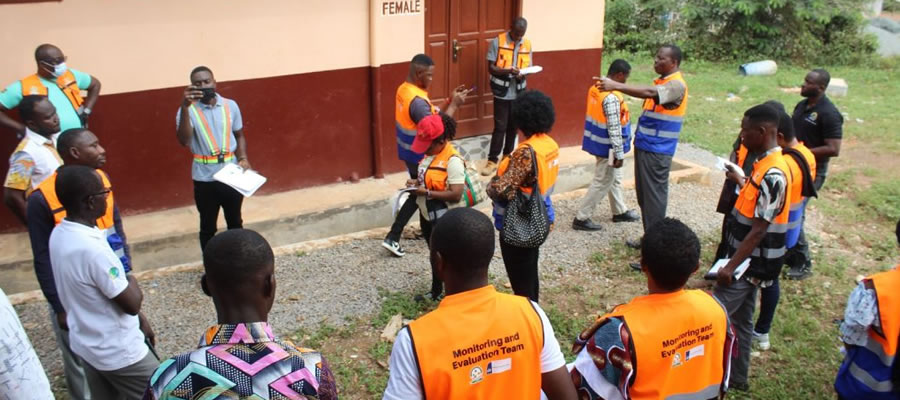

The Assembly was establish by legislative instrument 1385 as one of the 110 Assembly’s, country wide prescribed by the 1992 constitution and the Local Government Law 1991 Act 462. It is the highest political authority in the Assembly vested with powers to deliberate, legislate plan and develop through the preparation and effective implementation of development plans and budget.
Act 480 for 1994 the National Development Planning System, entreats the Assembly to formulate programmes, strategies and projects and see to the implementation, monitoring and evaluation, using available resources.
The Assembly can be compared to parliament as a legislative body making byelaws . An administrative and political head and the heads of the administration, the institutional set up are indicated in the figures below.
Composition Of the Assembly
In accordance with the Local Government Act, The Assembly is made up of the Executive Committee with the Municipal chief Executive appointed by the President of Ghana and approved by two-third majority of the Assembly members. Based on the L.I.1385 Assembly has 81 members with two-third i.e 54 elected by their respective constituents and the remaining one-third appointed by the president in consultation with the traditional authorities and other recognized interest groups in and 2 Members of Parliament who represents the 2 constituencies as ex-officio members of the Assembly.
They therefore have no power of voting. A Presiding Member who presides over meetings of the General Assembly is elected by two-thirds majority of then 72 members of the Assembly. The Assembly has two (2) committee: Executive and Public Relations and compliant with Nine (9) sub-Committees. The institutional structure of the Assembly is indicated in figure 8 & 9
Responsibilities Of Assembly Persons (Members):
By Act 462, all Assembly members are to perform the below functions:
- Keep closer contact with their respective constituents by consulting the electorates on issues to be deliberated at the General Assembly, forwarding their opinions, views and proposals to the Assembly for action
- Giving their electorate feedback on discussions of the Assembly and its Executive Committees
- Organise and take part in development activities in the Assembly
- Maintain frequent liaison with organized production and economic groupings.
Decentralized Departments
Apart from Game and Wildlife and Department of Rural Housing and Cottage Industries. The Assembly has the full complement of the decentralized departments. See Appendix 1 for list of existing decentralized departments
The accumulations of problems over the years somehow affect the efficient and decentralized management of development policies, which could have empowered people to participate in and influence the process of development. Therefore regulatory and institutional framework to promote and sustain administrative working at the sub-structures need to be reviewed to make them proactive.
The relationship between the Assembly and the private business sector and civil society is not very cordial due to insufficient awareness creation about the district Assembly concept. There is the need to maintain a symbolic relationship between the Assembly and Civil Society. The Assembly recognize the importance of the private sector .
There is some collaboration between the Assembly and the Private Sector. Significant in-roads had been made in the form of development infrastructure like school, water, feeder roads and health facilities. In most cases the private mining companies compliment the efforts of the Assembly. The Assembly has not been able to foster a stronger relationship with the public and private sector in terms of partnership to undertake projects. There has not been effective development plans at all levels to create an enabling environment for private sector and public development.
The Assembly working relationship with the NGOs is cordial, but more is required to be done. The activities of NGOs are not integrated in development plans. The Assembly has two NGOs and quite a number of community base organizations (CBOs) operating in various spheres of lives of the people . Lack of regular planning and programming between the District Assembly and partners has inhibited joint initiatives to promote poverty reducing programmes and encouraging growth.
Hence they are unable to identify areas of common interest and to provide the requisite support to enhance development. There is therefore the need to bring all NGOs and CBOs together to foster stronger working relationships for a comprehensive development .
Lack of communication and information flow has created misgivings within the civil society and private sector about governance at the district level.
Land tenure system is seriously impeding the private sector development. The Assembly has no land in place that can be offered for investment, apart from the concession of various mining companies. To encourage the Private Sector partnership, the Assembly need to acquire land as Land Banks, which can be offered to private investors to promote development.
Institutionalization of community participation in decision making or planning can harness good governance and improve upon the responsive relations between the district administration and civil society. To ensure a sustainable decentralization, there is an attempt to strengthen all the sub-structures to play their respective roles. Infrastructure is being provided and staff recruited to make the sub level structures operational.
The sub-structures of the Assembly are supposed to be functioning to give meaning to the decentralization concept. The Assembly has eleven (11) Area Councils and two (2) Urban Councils at Tarkwa and Prestea. The Assembly training Course in participatory planning are often organized for the Chairman and clerks of Urban and Area Councils to enable them prepare development plans and budgets at the grassroots levels. One thing that is lacking is community sensitization participation techniques which when used will bring all on board to enhance development.
They are saddled with many problems such as logistics, accommodation and training. This has made majority of them not functioning as expected. For now one major activity is revenue mobilization but then due to lack of training very little achievement is made. Revenue from markets, which is their backbone, is not forthcoming because people fail to pay because the market infrastructure lacks basic facilities and others.
During a visit to all the Area councils it came to light that most of the staff at the Area Councils do not know their roles and many people also do not know of their existence. There is a total lack of public information on the operations of the sub-structure levels by the general public.
Date Created : 11/21/2017 5:12:54 AM












 facebook
facebook
 twitter
twitter
 Youtube
Youtube
 +233 593 831 280
+233 593 831 280 0800 430 430
0800 430 430 GPS: GE-231-4383
GPS: GE-231-4383 info@ghanadistricts.com
info@ghanadistricts.com Box GP1044, Accra, Ghana
Box GP1044, Accra, Ghana